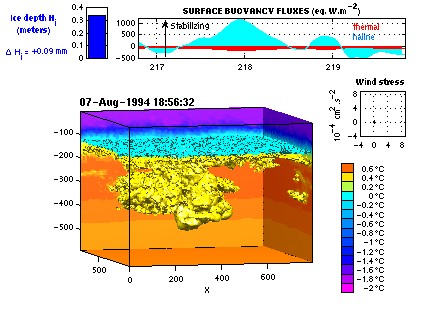Large Eddy Simulation
LES Model Description
The LES model, developed by Deardorff (1980)
and Moeng (1984) for the
atmospheric boundary layer, dynamically solves for unresolved (subgrid)
turbulent kinetic energy (TKE). Several adaptations of this model are currently
used to model oceanic boundary layers, including high-latitude deep convection
in response to storm forcing (Harcourt et
al., 2001), and forced convection in
more shallow free-slip ocean boundary layers (e.g.
Skyllingstad and Denbo, 1995; Wang et al, 1996).
LES Detailed Description
Preliminary Work Completed
Several LES runs have been carried out to test the stability of the
upper ocean under conditions observed during ANZFLUX at certain times when
ocean observations were not made. In general, they agree with the LTC results
of McPhee (2000), showing the
upper ocean becoming unstable to a process of
thermobaric parcel detrainment, but at an earlier point in time. These
simulations do not yet account for cabbeling effects, as this term was omitted
in the preliminary simulations for comparison with LTC results.

Two of the first simulations are presented on a separate document.
Simulation 3 was performed with a domain of 128x128x64 grid points, extended to
128x128x168 after one simulated day. The time step is 4s and the grid resolution 6m.
The LES was initialized from averaged typical profiles
measured in 1994 on year days 216 and 217 by the Turbulent Instrument Cluster and CTD,
and forced with time-dependent surface stress deduced from observations.
Potential temperature is shown on 2 vertical sections and two isothermal surfaces at 0°C
(above) and 0.4°C (below) representative of the pycnocline. The
animation (5Mb) illustrates the evolution
of the plumes into a major convective cell that spreads when it reaches a level of neutral
buoyancy near 300m depth.
Simulation 3 expanded analysis
The Proposal
We propose that this preliminary work on LES model development be
verified through quantitative comparisons with existing data sets
from polar boundary layers below ice, and subsequently be used to make
predictions about upper ocean instabilities for use in motivating and designing future
experiments in the Weddell Sea.
Plans for model-data comparison and experiment design
Maintained by Eun and Myung Park
